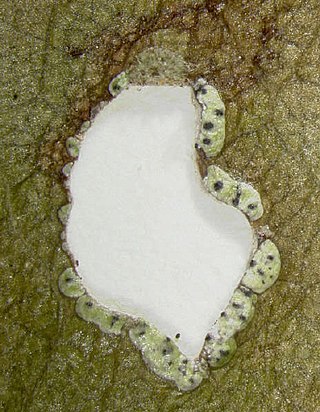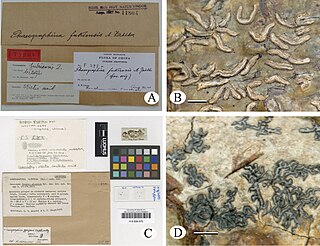
Sordariomycetes is a class of fungi in the subdivision Pezizomycotina (Ascomycota). It is the second-largest class of Ascomycota, with a worldwide distribution that mostly accommodates terrestrial based taxa, although several can also be found in aquatic habitats. Some are phytopathogens that can cause leaf, stem, and root diseases in a wide variety of hosts, while other genera can cause diseases in arthropods and mammals.

The Hypocreales are an order of fungi within the class Sordariomycetes. In 2008, it was estimated that it contained some 237 genera, and 2647 species in seven families. Since then, a considerable number of further taxa have been identified, including an additional family, the Stachybotryaceae. Wijayawardene et al. in 2020 added more families and genera to the order. According to the Catalog of Life, As of April 2021 the Hypocreales contains 6 families, 137 genera, and 1411 species. Hyde et al. (2020a) listed 14 families under Hypocreales, while, Wijayawardene et al. (2022) accepted 15 families in the order, where Cylindriaceae was additionally added. Earlier, Hyde et al. (2020a) had placed Cylindriaceae in class Xylariomycetidae. Samarakoon et al. (2022) agreed. Hence, Cylindriaceae should have been excluded from Hypocreales and placed in Xylariomycetidae. Xiao et al. (2022) recently introduced a new family Polycephalomycetaceae to Hypocreales.

Dothideomycetes is the largest and most diverse class of ascomycete fungi. It comprises 11 orders 90 families, 1,300 genera and over 19,000 known species. Wijayawardene et al. in 2020 added more orders to the class.

The order Sordariales is one of the most diverse taxonomic groups within the Sordariomycetes.

The Sordariaceae are a family of perithecial fungi within the Sordariales order.

Pleosporaceae is a family of sac fungi. They are pathogenic to humans or saprobic on woody and dead herbaceous stems or leaves.

Dothideales are an order of bitunicate fungi consisting mainly of saprobic or plant parasitic species.
The Lophiostomataceae are a family of fungi in the order Pleosporales. Taxa have a widespread distribution, especially in temperate regions, and are saprobic or necrotrophic on herbaceous and woody stems.

Lophiostoma is a genus of ascomycetous fungi in the family Lophiostomataceae.
The Hyponectriaceae are a family of fungi, that was formerly in the order Xylariales. It was placed in the Amphisphaeriales order in 2020.
Jobellisia is a genus of fungi within the monotypic family Jobellisiaceae and the monotypic order Jobellisiales and also the subclass Hypocreomycetidae, and class Sordariomycetes. The genus was circumscribed by Margaret Elizabeth Barr-Bigelow in 1993 with Jobellisia luteola as the type species. It contains species that grow on dead wood and bark in tropical and temperate regions of the Northern Hemisphere.
The Trichosphaeriales are an order of sac fungi. It is monotypic, and consists of the single family, the Trichosphaeriaceae. In 2017, the family of Trichosphaeriaceae was placed in Diaporthomycetidae families incertae sedis, which was accepted by Wijayawardene et al. (2018), and Wijayawardene et al. 2020. The order of Trichosphaeriales was also unplaced. They are generally saprobic and pathogenic on plants, commonly isolated from herbivore dung.

The Annulatascaceae are a family of fungi in the monotypic order Annulatascales of the class Sordariomycetes of the Ascomycota. The family had not been assigned to any order, until 2020 when it was placed with a new order Annulatascales M.J. D'souza, Maharachch. & K.D. Hyde.
The Papulosaceae are a family of fungi in the class Sordariomycetes and in the subclass Diaporthomycetidae. The family has not been assigned to any order. A monotypic taxon, the Papulosaceae contained the single genus Papulosa, which in turn contains the single species Papulosa amerospora. This species, found in the eastern USA, grows in Juncus stems.

The Chaetomiaceae are a family of fungi in the Ascomycota, order Sordariales, class Sordariomycetes. Chaetomiaceae are usually saprobic or parasitic. Cheatomiaceae are a great source of enzymes with diverse biotechnological and industrial applications such as PMO, L-methioninase, β-1,3-glucanase, laccase, dextranase, lipolytic, pectinolytic, amylolytic, chitinolytic, and proteolytic enzymes. The production of such compounds can be taken into account as candidates for the development of effective and novel lead compounds for medicine, biological control and production of bioactive secondary metabolites. Chaetomiaceae furthermore contains some of the most well known thermophilic fungi, an interesting feature carrying many biological applications, but that is found only in few fungal genera.

The Apiosporaceae are a family of fungi in the Ascomycota. It was placed in the order Amphisphaeriales in 2020.

The Magnaporthales are an order of fungi within the class Sordariomycetes and subclass Diaporthomycetidae. It has several water based species and genera.

Coniochaetaceae is a fungal family in the order Coniochaetales. The family was updated in 2020.

Strigulaceae is a family of lichen-forming fungi, one of two families in the order Strigulales. Recent (2020) molecular analysis of the type genus, Strigula, has led to a reallocation of the foliicolous species into six genera that correspond to well-delimited clades with diagnostic phenotype features.

Graphidales is an order of lichen-forming fungi in the class Lecanoromycetes. It contains 6 families, about 81 genera and about 2,228 species. Family Graphidaceae are the largest crustose family within Graphidales order comprising more than 2000 species, which are widely distributed in tropical and subtropical regions of the world.















